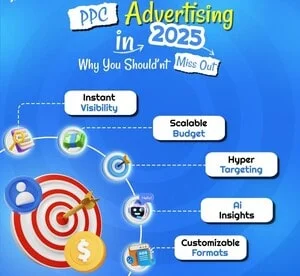Mediabuying in digitalmarketing refers to the process of purchasing advertising space or time on various media platforms such as websites, social media platforms, apps, and search engines. It involves strategic planning, negotiation, and execution to reach the target audience effectively.
Digitalmarketing has emerged as a powerful tool in the modern era, with increasing numbers of people spending significant amounts of time online. According to a report by eMarketer, worldwide digitalad spending is expected to reach $452.7 billion in 2022, representing 57.2% of total media ad spending. This statistic highlights the growing significance of digital marketing and the importance of media buying within this realm.
Fresh look at global CPC and CPM benchmarks.
In the early days of online advertising, media buying primarily revolved around banner ads and pop-up ads. However, with the evolution of technology and the rise of sophisticated targeting options, media buying has become more data-driven and precise. Advertisers can now leverage advanced algorithms and machine learning to identify and target specific demographics, interests, and buying behaviors.
One of the key advantages of media buying in digital marketing is its ability to reach a global audience. Through programmatic advertising, advertisers can target relevant audiences across different countries and demographics with ease. According to Statista, the global digital population stood at 4.8 billion as of January 2022. This vast online population presents a tremendous opportunity for advertisers to reach a wide range of potential customers.
In recent years, the shift towards mobile devices has significantly influenced media buying strategies. With the proliferation of smartphones, people are accessing the internet through mobile apps and mobile-optimized websites. As a result, advertisers are now focusing on mobile advertising to capture the attention of users on-the-go. In fact, mobile advertising expenditure is projected to reach $376 billion globally by 2023, according to Zenith’s Mobile Advertising Forecasts.
Furthermore, media buying in digital marketing enables advertisers to track and measure their campaigns’ performance effectively. Through various analytics tools, advertisers can monitor metrics such as impressions, clicks, conversions, and return on investment (ROI). This data-driven approach allows for optimization and refinement of advertising strategies to achieve better results.
To navigate the complex landscape of media buying in digital marketing, many advertisers rely on specialized online advertising services and advertising networks. These platforms offer comprehensive solutions, including identifying the most appropriate advertising channels, negotiating favorable ad placements, and providing real-time performance tracking. By leveraging these services, advertisers can achieve greater efficiency and effectiveness in their media buying efforts.
In conclusion, media buying in digital marketing plays a vital role in reaching and engaging target audiences effectively. As the digital landscape continues to evolve, advertisers must adapt their strategies and leverage the power of media buying to stay ahead in the ever-changing online advertising industry.
Table of Contents
- What is Media Buying in Digital Marketing? A Comprehensive Guide to Enhancing Your Online Advertising Strategy
- What Is Media Buying in Digital Marketing
- Understanding Media Buying
- Role of Media Buying in Digital Marketing
- Types of Media Buying
- The Importance of Media Buying in Digital Marketing
- Conclusion
- Key Takeaways: What Is Media Buying In Digital Marketing
- FAQs About Media Buying in Digital Marketing
- 1. What is media buying?
- 2. Why is media buying important in digital marketing?
- 3. How does media buying work in the digital marketing landscape?
- 4. What are the benefits of using a media buying service?
- 5. How do media buying services target the right audience?
- 6. How do media buying services ensure ad placements on reputable websites?
- 7. What is programmatic media buying?
- 8. How do media buying services ensure ad viewability?
- 9. Can media buying services help with budget management?
- 10. Are there any risks involved in media buying?
- 11. How do media buying services track the performance of ads?
- 12. Is media buying only suitable for big businesses?
- 13. Can media buying services help with retargeting campaigns?
- 14. How long does it take to see results through media buying?
- 15. Can media buying services help with ad creative development?
- Conclusion: Key Points and Insights about Media Buying in Digital Marketing
What is Media Buying in Digital Marketing? A Comprehensive Guide to Enhancing Your Online Advertising Strategy
Media buying is an integral part of digital marketing that involves the strategic purchase of advertising space across various online platforms. But what exactly does media buying entail and how can it benefit your online advertising strategy? In this comprehensive guide, we will delve into the depths of media buying, exploring its definition, advantages, and its vital role in maximizing the effectiveness of your online marketing campaigns. So, let’s dig in and discover how media buying can revolutionize your online advertising efforts.
What Is Media Buying in Digital Marketing
As the world becomes increasingly digital, businesses are turning to online platforms and digital marketing strategies to reach their target audience. One crucial aspect of digital marketing is media buying. Media buying involves the purchasing of advertising space or time on various digital platforms to promote a product or service.
Understanding Media Buying
Media buying is a strategic process in digital advertising that involves planning, negotiating, and executing the purchase of ad space or time through various channels such as websites, social media platforms, search engines, mobile apps, and more. The goal of media buying is to deliver the right message to the right audience at the right time.
Media buying can be done directly or through programmatic advertising. Direct media buying involves direct negotiations between advertisers and publishers, while programmatic media buying uses technology and algorithms to automate the buying and selling of ad inventory.
Role of Media Buying in Digital Marketing
Media buying plays a crucial role in digital marketing strategies as it helps businesses maximize their reach, target specific audiences, and drive conversions. Here are some key roles media buying plays in digital marketing:
- Targeting the Right Audience: Media buying allows advertisers to target their ads to specific demographics, interests, or behaviors. This level of audience segmentation helps businesses to reach the right people who are most likely to be interested in their products or services.
- Increase Brand Visibility: With media buying, businesses can increase their brand’s visibility by placing ads on popular websites, social media platforms, or other high-traffic digital platforms. This exposure helps in building brand awareness and recognition among the target audience.
- Drive Traffic: Media buying helps in driving traffic to a business’s website or landing page. By placing well-targeted ads on relevant platforms, businesses can attract potential customers and direct them to their online platforms, leading to increased leads and potential sales.
- Optimized Ad Performance: Media buying allows advertisers to track and analyze the performance of their ads in real-time. This helps in optimizing ad campaigns by identifying what works and what doesn’t, allowing businesses to make data-driven decisions to improve their ad performance.
- Cost-Effective Advertising: Media buying can help businesses optimize their advertising budgets by targeting specific audiences and platforms. By buying ad space or time directly from publishers or utilizing programmatic buying, businesses can ensure their ads are shown to the right people, reducing wasted ad spend.
Types of Media Buying
Media buying in digital marketing can be classified into several types, depending on the channels, platforms, or formats used. Some common types of media buying include:
- Display Advertising: Display advertising involves buying ad space on websites, blogs, or other digital platforms. These ads can be in the form of banners, videos, or interactive elements.
- Social Media Advertising: Social media platforms like Facebook, Instagram, Twitter, LinkedIn, and YouTube offer advertising options where businesses can buy ad space to target specific users based on their demographics, interests, or behaviors.
- Search Engine Advertising: Search engine advertising, such as Google Ads, allows businesses to buy ad space on search engine result pages (SERPs) based on specific keywords or search queries.
- Mobile Advertising: Mobile advertising involves buying ad space on mobile apps, websites, or other mobile platforms to target users who are browsing on their smartphones or tablets.
- Video Advertising: Video advertising includes buying ad space or time on video-sharing platforms like YouTube or in-stream video ads on other digital platforms.
- Native Advertising: Native advertising is a form of media buying where ads are seamlessly integrated into the content of a platform, such as sponsored articles, branded content, or recommended products.
Each type of media buying has its own advantages and effectiveness in reaching specific target audiences and achieving marketing objectives.
The Importance of Media Buying in Digital Marketing
Media buying is an essential component of any digital marketing strategy. It helps businesses effectively reach their target audience, increase brand visibility, drive website traffic, and achieve marketing objectives. Here are a few reasons why media buying is crucial in digital marketing:
- Improved Targeting: Media buying enables advertisers to target specific demographics, interests, or behaviors, ensuring that their message is delivered to the right audience, increasing the chances of engagement and conversions.
- Enhanced Reach: Through media buying, businesses can extend their reach and place their ads on popular platforms with a wide user base. This exposure helps in attracting potential customers who may not have been aware of the brand otherwise.
- Increased Conversion Rates: By targeting the right audience, media buying can significantly impact conversion rates. When ads are shown to the right people who are interested in the product or service, the likelihood of them taking action increases, resulting in higher conversion rates.
- Measurable Results: Media buying allows advertisers to track and analyze the performance of their ads in real-time. This data-driven approach helps in measuring the effectiveness of campaigns and making adjustments to improve ad performance and ROI.
- Competitive Advantage: Utilizing media buying strategies gives businesses a competitive edge by placing their brand in front of the right audience at the right time. This helps in building brand awareness, recognition, and loyalty, leading to long-term business growth.
Conclusion
Media buying in digital marketing is a strategic process that plays a vital role in reaching target audiences, increasing brand visibility, driving website traffic, and achieving marketing objectives. By leveraging the power of media buying, businesses can optimize their ad campaigns, ensure better targeting, and drive meaningful results. In the ever-evolving digital landscape, media buying remains a crucial aspect of successful digital marketing strategies.
Statistic: According to a survey by eMarketer, digital advertising spending is forecasted to reach $389.29 billion worldwide in 2021, highlighting the significance of media buying in the digital marketing industry.
Key Takeaways: What Is Media Buying In Digital Marketing
Media buying plays a crucial role in digital marketing campaigns as it involves the strategic acquisition of advertising space on various online platforms to reach target audiences effectively. This article aims to provide a comprehensive understanding of media buying in digital marketing. The key takeaways from this article are as follows:
- Definition: Media buying refers to the process of purchasing digital advertising space on various online platforms such as websites, social media platforms, search engines, and mobile apps to promote products or services.
- Role of Media Buying: It helps businesses connect with their target audience by selecting the right advertising channels and optimizing the ad placements to maximize reach and engagement.
- Types of Media Buying: Media buying can be categorized into direct and programmatic buying. Direct buying involves purchasing ad space directly from publishers or media representatives, while programmatic buying uses automated technology and data to buy ad space in real-time auctions.
- Pricing Models: Media buying utilizes various pricing models such as Cost Per Thousand (CPM), Cost Per Click (CPC), and Cost Per Acquisition (CPA) to ensure optimal return on investment (ROI).
- Targeting and Segmentation: Media buying enables advertisers to target specific audiences based on demographics, interests, behavior, and location, ensuring that ads are shown to the right people at the right time.
- Ad Formats: Different ad formats, including display ads, video ads, native ads, and sponsored content, can be utilized in media buying to cater to different marketing objectives and platforms.
- Media Planning: Successful media buying requires effective media planning, which involves defining campaign objectives, identifying target audiences, setting budgets, and determining the optimal ad placements.
- Audience Research and Analysis: Media buying relies on thorough audience research and analysis to understand consumer behavior, preferences, and the most suitable channels for reaching the target audience.
- Ad Placement Optimization: Media buyers continuously monitor and optimize ad placements to ensure maximum visibility and engagement. This involves analyzing performance metrics, adjusting bids, and leveraging data-driven insights.
- Ad Tracking and Measurement: Media buying incorporates robust tracking and measurement techniques to evaluate campaign performance, track conversions, and understand the effectiveness of advertising efforts.
- Relationship Building: Media buyers establish strong relationships with publishers, advertising networks, and other industry stakeholders to negotiate favorable deals, access premium inventory, and stay informed about the latest advertising trends and opportunities.
- Ad Fraud Prevention: Media buying involves implementing measures to combat ad fraud and ensure that advertisers’ budgets are not wasted on fraudulent or non-viewable impressions. This includes utilizing ad verification tools and partnering with trusted publishers.
- Real-time Optimization: With programmatic media buying, advertisers can leverage real-time data and automated optimization algorithms to improve ad targeting, creative performance, and overall campaign efficiency on a per-impression basis.
- Strategic Partnerships: Media buying benefits from forming strategic partnerships with technology platforms, data providers, and other relevant partners to gain access to advanced targeting capabilities and audience insights.
- Testing and Experimentation: Media buying allows advertisers to test different ad formats, messaging, and targeting strategies to identify the most effective combinations for driving desired outcomes and improving campaign performance.
- Continuous Learning and Adaptation: Media buying in digital marketing is an iterative process that requires staying updated with industry trends, consumer behavior, and emerging advertising technologies to stay ahead of the competition and achieve long-term success.
By understanding these key takeaways, advertisers and marketers can better comprehend the importance of media buying in digital marketing and strategize their advertising efforts to effectively reach and engage their target audience, optimize campaign performance, and drive desired outcomes.
FAQs About Media Buying in Digital Marketing
1. What is media buying?
Media buying is the process of purchasing advertising space or time on various media platforms, such as websites, social media channels, TV, radio, or print publications, to promote a product or service.
2. Why is media buying important in digital marketing?
Media buying allows advertisers to strategically place their ads in front of their target audience, maximizing the reach and effectiveness of their marketing campaigns. It helps to increase brand awareness, drive website traffic, and generate leads or sales.
3. How does media buying work in the digital marketing landscape?
In digital marketing, media buying involves identifying the most relevant digital platforms and negotiating with publishers or advertising networks to secure ad space. Advertisers then create compelling ad creatives and launch campaigns to reach their target audience at the right time and place.
4. What are the benefits of using a media buying service?
A media buying service can provide expertise and access to a vast network of media platforms. They can optimize your ad spend, negotiate better rates, and track and measure the performance of your campaigns, ensuring you get the best return on investment (ROI).
5. How do media buying services target the right audience?
Media buying services use various targeting options, such as demographic data, geographic location, interests, behavior, or browsing history, to reach the desired audience. They leverage data and technologies to display ads only to those who are most likely to be interested in the product or service.
6. How do media buying services ensure ad placements on reputable websites?
Media buying services have relationships with trusted publishers and advertising networks. They carefully select the platforms that align with your brand values and audience preferences to ensure your ads appear on reputable websites or platforms, minimizing the risk of ad fraud or brand damage.
7. What is programmatic media buying?
Programmatic media buying is an automated process where ad placements are bought and sold in real-time through technology platforms and algorithms. It allows advertisers to target specific audiences and optimize their campaigns based on data-driven insights.
8. How do media buying services ensure ad viewability?
Media buying services monitor ad viewability by working with partners and using specialized tools to track impressions and detect fraudulent or non-viewable ad placements. They continuously optimize campaigns to improve viewability and ensure ads are seen by the target audience.
9. Can media buying services help with budget management?
Yes, media buying services can assist with budget management. They analyze market trends, negotiate rates, and optimize ad placements to help you get the most out of your advertising budget, ensuring efficient spending and maximizing the impact of your campaigns.
10. Are there any risks involved in media buying?
While media buying can be a highly effective marketing strategy, there are some risks involved. These include ad fraud, viewability issues, ad-blockers, and brand safety concerns. However, working with reputable media buying services can help mitigate these risks.
11. How do media buying services track the performance of ads?
Media buying services use advanced tracking tools and analytics platforms to measure key performance indicators (KPIs) such as impressions, clicks, conversions, and ROI. They provide detailed reports and insights to help you understand the effectiveness of your campaigns.
12. Is media buying only suitable for big businesses?
No, media buying can be beneficial for businesses of all sizes. Whether you are a small start-up or a large enterprise, media buying allows you to target a specific audience, optimize your budget, and achieve your marketing goals effectively.
13. Can media buying services help with retargeting campaigns?
Yes, media buying services can assist with retargeting campaigns. They use cookies and tracking pixels to identify users who have previously interacted with your website or ads and display targeted ads to them, increasing the likelihood of conversion.
14. How long does it take to see results through media buying?
The time it takes to see results through media buying depends on various factors such as industry, competition, campaign objectives, and targeting. Generally, you can expect to see initial results within a few weeks, but optimal results may take months of continuous optimization.
15. Can media buying services help with ad creative development?
While media buying services primarily focus on ad placement and campaign optimization, some also offer creative services. They can assist in developing impactful ad creatives or connect you with trusted design agencies to ensure your ads resonate with your target audience and drive engagement.
Conclusion: Key Points and Insights about Media Buying in Digital Marketing
In conclusion, media buying is a crucial aspect of digital marketing that enables businesses to reach their target audience effectively and efficiently. It involves the strategic purchase of ad space or inventory from publishers or advertising networks to display targeted ads to the right users at the right time. Here are the key points and insights covered in this article:
1. Importance of media buying: Media buying is essential for businesses as it helps them maximize their advertising budget and ensure that their ads are seen by the right people. By identifying their target audience and utilizing data-driven insights, marketers can leverage media buying to achieve higher conversions and ROI. It allows businesses to display ads across various platforms and channels, whether it be social media, search engines, or websites, and effectively engage with their target market.
2. Targeting and segmentation: Media buying offers advanced targeting and segmentation capabilities, allowing marketers to reach their desired audience with precision. Through data analysis and audience segmentation, advertisers can create tailored ad campaigns that resonate with specific demographics, interests, or purchasing behavior. By narrowing down the target audience, media buying minimizes ad waste and maximizes ad effectiveness, resulting in higher conversion rates and better overall campaign performance.
3. Programmatic media buying: Programmatic media buying has revolutionized the digital advertising landscape. It utilizes automated algorithms and real-time bidding to buy ad impressions across multiple ad exchanges and publishing platforms. This process eliminates the need for manual negotiation and streamlines the ad buying process. With programmatic media buying, advertisers can precisely target their ads, optimize campaigns in real-time, and allocate budgets based on performance metrics. This data-driven approach enhances the efficiency and effectiveness of digital advertising, enabling businesses to deliver highly relevant ads to their target audience.
4. Ad fraud prevention: Ad fraud is a significant concern in digital marketing, and media buying plays a vital role in mitigating this risk. By partnering with reputable advertising networks and utilizing fraud detection tools, marketers can minimize the chances of their ads being displayed on fraudulent or low-quality websites. Additionally, media buying platforms offer features that enable advertisers to monitor ad viewability and ad placement, ensuring that their ads are seen by genuine users in brand-safe environments.
5. Measurement and optimization: Media buying provides marketers with the ability to measure and optimize their ad campaigns continuously. By utilizing tracking pixels, conversion pixels, and other performance tracking tools, advertisers can gather valuable data on ad impressions, clicks, conversions, and other key performance indicators. This data-driven approach allows marketers to make data-backed decisions, fine-tune their targeting strategies, and optimize their campaigns for better results. By monitoring campaign performance and making necessary adjustments, media buying empowers advertisers to improve their return on investment and achieve their marketing goals.
In conclusion, media buying is a fundamental component of digital marketing that enables businesses to connect with their target audience effectively. By utilizing advanced targeting, programmatic automation, and measurement tools, marketers can optimize their ad campaigns, maximize their advertising budget, and achieve higher conversion rates. As digital advertising continues to evolve, media buying remains a crucial strategy for businesses looking to thrive in the online marketplace.
Buy Traffic • Performance Marketing Tips • Advertising Platform for Marketers • Self-Serve DSP Platform



